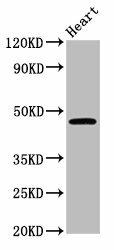Description
| Antibody Name: | CERS3 Antibody (PACO58268) |
| Antibody SKU: | PACO58268 |
| Size: | 50ug |
| Host Species: | Rabbit |
| Tested Applications: | ELISA, WB |
| Recommended Dilutions: | ELISA:1:2000-1:10000, WB:1:500-1:5000 |
| Species Reactivity: | Human, Mouse |
| Immunogen: | Recombinant Human Ceramide synthase 3 protein (59-134AA) |
| Form: | Liquid |
| Storage Buffer: | Preservative: 0.03% Proclin 300 Constituents: 50% Glycerol, 0.01M PBS, pH 7.4 |
| Purification Method: | >95%, Protein G purified |
| Clonality: | Polyclonal |
| Isotype: | IgG |
| Conjugate: | Non-conjugated |
 | Western Blot. Positive WB detected in: Mouse heart tissue. All lanes: CERS3 antibody at 3.6µg/ml. Secondary. Goat polyclonal to rabbit IgG at 1/50000 dilution. Predicted band size: 47 kDa. Observed band size: 47 kDa. |
| Background: | Has (dihydro)ceramide synthesis activity with relatively broad substrate specificity, but a preference for C18:0 and other middle- to long-chain fatty acyl-CoAs (By similarity). It is crucial for the synthesis of very long-chain ceramides in the epidermis, to maintain epidermal lipid homeostasis and terminal differentiation. |
| Synonyms: | Ceramide synthase 3 (CerS3) (EC 2.3.1.24) (Dihydroceramide synthase 3) (LAG1 longevity assurance homolog 3), CERS3, LASS3 |
| UniProt Protein Function: | Has (dihydro)ceramide synthesis activity with relatively broad substrate specificity, but a preference for C18:0 and other middle- to long-chain fatty acyl-CoAs (). It is crucial for the synthesis of very long-chain ceramides in the epidermis, to maintain epidermal lipid homeostasis and terminal differentiation. |
| UniProt Protein Details: | |
| NCBI Summary: | This gene is a member of the ceramide synthase family of genes. The ceramide synthase enzymes regulate sphingolipid synthesis by catalyzing the formation of ceramides from sphingoid base and acyl-coA substrates. This family member is involved in the synthesis of ceramides with ultra-long-chain acyl moieties (ULC-Cers), important to the epidermis in its role in creating a protective barrier from the environment. The protein encoded by this gene has also been implicated in modification of the lipid structures required for spermatogenesis. Mutations in this gene have been associated with male fertility defects, and epidermal defects, including ichthyosis. Alternative splicing results in multiple transcript variants encoding different isoforms. [provided by RefSeq, Aug 2015] |
| UniProt Code: | Q8IU89 |
| NCBI GenInfo Identifier: | 594140617 |
| NCBI Gene ID: | 204219 |
| NCBI Accession: | NP_001277270.1 |
| UniProt Secondary Accession: | Q8IU89,Q8NE64, Q8NEN6 |
| UniProt Related Accession: | Q8IU89 |
| Molecular Weight: | 46,316 Da |
| NCBI Full Name: | ceramide synthase 3 isoform 1 |
| NCBI Synonym Full Names: | ceramide synthase 3 |
| NCBI Official Symbol: | CERS3 |
| NCBI Official Synonym Symbols: | ARCI9; LASS3 |
| NCBI Protein Information: | ceramide synthase 3 |
| UniProt Protein Name: | Ceramide synthase 3 |
| UniProt Synonym Protein Names: | Dihydroceramide synthase 3; LAG1 longevity assurance homolog 3 |
| Protein Family: | Ceramide synthase |
| UniProt Gene Name: | CERS3 |
| UniProt Entry Name: |






